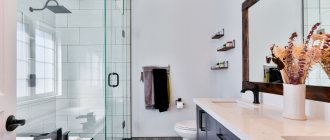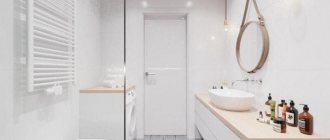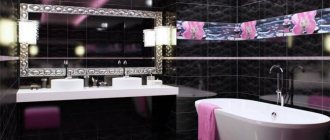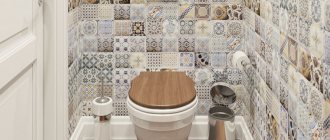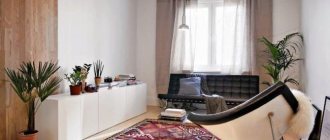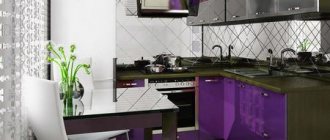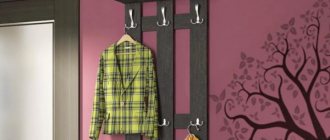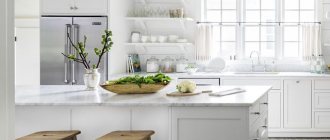A modern, stylish tile shower is a worthy alternative to bulky bathtubs and showers, especially for owners of small bathrooms. There is an opportunity to realize all your desires, give the opportunity to let your designer’s imagination run wild and, with a little effort, bring non-standard ideas to life. A small corner or niche in the bathroom can be turned into a comfortable and beautiful mini-zone, and the usual showering procedure can be turned into pleasant relaxation.
A tiled shower is a traditional solution that provides comfortable conditions for taking water procedures.
Which tile is best for a shower stall?
Ceramic tiles are simply the ideal facing material for a shower. Depending on the surface, it can be:
- glossy;
- matte;
- embossed;
- rough.
Options with a glossy finish will look great on the walls. They shine very effectively and shimmer in the light. Tile with various relief designs (depicting animals, flowers, butterflies, fish, birds, etc.) can be an excellent decoration for walls. The drawings can be either small or in the form of large bright panels consisting of several elements.
The tiles create a fairly aesthetic and elegant design, both in a city apartment and in a country house.
You can opt for a mosaic. It is very often used in combination with regular tiles. Using mosaics, they lay out unusual colorful panels or bright floral patterns that will help turn an ordinary shower into a unique masterpiece.
To cover the pallet, it is better to use tiles with a matte and rough surface. It will help prevent slipping on wet floors.
The choice of colors, prints and textures is purely a matter of personal taste.
When purchasing tiles, special attention should be paid to moisture absorption and wear resistance. It’s better not to save money and choose high wear resistance. Another very important addition: it is better to cover the shower tray with tiles with the least moisture absorption. All information about the product is indicated on the packaging.
The finishing must not only be beautiful, but also meet certain requirements.
Installation of formwork and reinforcement
The formwork is assembled from wooden boards, cutting out parts according to a previously prepared drawing. This can be a shape in the form of the letter L or the letter P, depending on the model and location of the shower tray. The boards on the screed are temporarily fixed in one position. The next task of the master is to reinforce the future pallet.
The main material is reinforcement with a cross-section of approximately 0.8 cm. A mesh is woven from rods equal in length. The resulting mesh is laid out on the prepared sand-cement screed. This stage of work is completed by installing internal formwork.
Advantages of a tile shower
The modern market offers a huge selection of all kinds of shower cabins. However, not all are suitable for a small room; they are often equipped with functions that are not used. Prices also do not always correspond to quality.
Compared to all ready-made shower cabins, a tile shower has many advantages:
- Tiles are considered an ideal material for tiling rooms with high humidity levels.
- It does not conduct electricity.
- It is characterized by high strength, safety and is an environmentally friendly material.
- Has a long service life.
- Allows you to disguise unaesthetic pipes that spoil the appearance of the room, as well as level the surface of the walls.
- With its help, you can realize any design solutions and all kinds of drawings and patterns thanks to the huge color palette and variety of shapes and structures.
- The ability to create a shower room suitable for a specific room.
- All of the above advantages will cost much less than a standard shower cabin.
Thanks to shower tile finishing, it is possible to create truly elegant accents in the interior.
The disadvantages of this design include insufficient sound insulation, which can be corrected with the help of an additional layer of sound insulation laid under the screed layer.
Overview of species
Today you can find various options for tile cabins, ranging from traditional classic ones to the most extraordinary models. The latter types include showers, in which tiles are laid not only on the surface of the floor, walls, but also on the ceiling.
Cabins with a floor drain and a miniature seat or a comfortable lounger are also very popular. They look similar to the baths in Turkey and are finished with tiles in light green and soft blue shades. There may also be built-in designs without a tray, but they are more suitable for small rooms.
The most common types of showers made of tiles include the following options.
- Mosaic. They are considered an original solution, since mosaics can be used to lay out various panels on the walls, creating a special atmosphere in the bathroom that is conducive to relaxation and rest. In addition, decorative elements combine well with other types of surface finishes in the room. But when covering a floor with such material, it is important to pay attention to its slip rate.
The tile must be heavy-duty and not slippery.
- Glass. In such booths, finishing materials are usually combined, for example, the surfaces of the walls and ceiling are covered with glass tiles, which must have an end and a thickness of at least 6 mm, and the floor is decorated with marble. This gives the interior a luxurious and expensive look.
- Tiled. This is the most popular type of cabin as it is easy to install and affordable. In addition, tiles are ideal for covering surfaces in rooms with high humidity levels.
Showers may also differ in the type of tray. There are cabins with a ready-made acrylic or enamel base, without a pallet and with a homemade elevation. The acrylic tray has a non-slip surface and is light weight, but may turn yellow after some time.
The enamel base has high performance characteristics, but its surface becomes slippery in contact with water. As for structures with a homemade pallet, it is usually made of bricks or concrete and trimmed with tiles.
If you want to give your bathroom a sophisticated look, it is recommended to additionally decorate tile showers with built-in shelves. To visually add depth to such niches, they should be lined with dark-colored tiles. Contrasting shades are also good; they will make the cabin more decorative. You can visually increase the area of your shower using large-format plain tiles.
It must be installed both on the floor and on the surface of the walls and ceiling, avoiding height differences.
Types of tiled showers
A built-in shower cabin made of tiles will organically fit into the interior of any bathroom, regardless of the size and stylistic design of the room. For example, the back of the structure can be decorated with tiles in dark colors, and the side walls can be decorated with contrasting light shades. Or decorate the back wall with a spectacular large panel, and complement the side walls with small mosaics made in the same style. The pallet can be tiled under stone or large pebbles. This built-in shower will be perfectly complemented by sliding glass doors, which can be frosted or patterned.
The photo shows a toilet combined with a bathtub and a shower without a tray with a glass door, tiled.
A very attractive built-in shower can be installed in a niche. Stylish high mirrored doors will be a great addition to it. Such a shower would be appropriate for a bright bathroom. A large mirror will help visually increase the space of the entire room.
Shower doors
The most popular material for shower doors is glass. If a shower is installed without a tray, the door should fit tightly to the floor, not allowing moisture to pass through. For safety, it is better to take tempered glass or triplex. These types of glass are not only stronger, but even if they break they do not pose a danger to humans. Hardened material crumbles into small, non-sharp fragments, and triplex has a special film on which the fragments will remain.
You can try to save money by buying regular glass 5-6 mm thick and applying film on both sides yourself. Before applying the film, the glass must be washed and degreased. It sticks to wet glass. Having received safety glass one way or another, you need to select awnings for glass doors and make holes in the glass for fastening. The latter is best left to a professional.
If you are afraid of splash marks from plumbing fixtures, then choose frosted glass or canvas with a special design. If you do not want to install a glass door, you can use translucent polycarbonate.
Dimensions of shower stalls with tile drain
You can assemble a shower structure with your own hands of any size and various shapes: rectangular, square, triangular, round and non-standard. Everything will depend on the size and shape of the bathroom. In a small bathroom, the shower stall should not exceed dimensions of 80x80cm.
For small spaces, showers with transparent glass walls are suitable, especially if they are located in the corner of the bathroom, they will be almost invisible.
This way you can visually enlarge the space and give it an interesting look.
In a large room, a spacious shower stall with original lighting and a bright, interesting panel located on the back wall, complemented by spectacular fittings, will look very presentable.
Shower colors with tile tray
It is better to decorate a small shower room with tiles in light shades; a mosaic in beige, soft blue or olive colors will look great. A mirror wall made of small mosaics will look great in a small bathroom.
The choice of color scheme directly depends on the dimensions of the room and its functional planning features.
The dark range of colors harmoniously combines with bright ceiling or side lighting.
When decorating a shower with mosaics, bright colors are used as eye-catching accents (borders, frames, wall panels).
Peculiarities
The shower is an ideal solution not only for those who are limited in finances, but also for owners of a small bathroom. If the room is small, then every square meter plays a role here. A shower room is the optimal solution that allows you to place everything you need in the bathroom. Of course, you can go to a construction or plumbing store and choose a ready-made design, but not everyone can afford the cost. Setting up a shower room yourself is a simple process that the apartment owner can handle if he has the necessary materials and tools. The tray is best made of tiles, but it is important to come up with a way to protect the space from water.
At the moment, there are two options for mounting the pallet:
- Independent construction of the structure from start to finish.
- Purchase a ready-made kit, which includes a polystyrene pallet with a frame. It is enough to equip the border and trim with ceramic tiles. You can protect the space with the help of handrails on which a waterproof curtain is hung.
As for the location of the shower, it all depends on the type of renovation. If a major renovation is planned, then you need to first determine the location of the plumbing, taking into account the location of the communication systems. In the case when the renovation has already been done and only the installation of the shower is carried out, then it is adjusted to the place that is free. Ideally, the shower room should be located in the corner opposite the entrance.
If we talk about the shape of the pallet, then most often they use round, semicircular, oval, triangular and square designs. The dimensions of the tray depend on the size of the room and the space that can be allocated for a shower without compromising the rest of the space. Ideally, the width of the shower should be no less than 0.7 meters.
Design options for tiled showers
Today there are absolutely no restrictions in bathroom design, regardless of the conditions. Guided by your own preferences, you can find interesting solutions in the form of mosaics and patterns, or choose very non-standard tile options that look like stone, pebbles, and even wood.
Tiles and mosaics
A shower stall tiled with mosaic tiles is practical, reliable and beautiful. It allows you to create a pattern of any complexity, and mirror elements can increase the space.
By adding such a characteristic touch as mosaic, the decor takes on a more thoughtful and complete look.
A textured pebble mosaic will help create a unique and inimitable relief, especially if you lay out a pallet - it will remind you of the warm sea coast.
Under the tree
Wood-effect tiles look very similar to wood in texture and texture, but at the same time have all the qualities inherent in ceramic tiles. It can imitate parquet masonry, wood mosaic, boards, lining or wood panels. It is used for cladding walls and floors. Wood-effect tiles in the bathroom look very stylish and original, adding warmth, tranquility and comfort to the interior.
Externally, it completely conveys the surface of natural wood, while possessing all the advantageous qualities of ceramic tiles.
The wood pattern consists of lines and stripes. It should be taken into account that longitudinal stripes narrow the room, and transverse stripes expand it. It is better to use tiles of darker colors as flooring. For walls, choose light shades.
Under the stone
The most popular are decorative collections that imitate the texture and color of wild stone, granite, slate and pebbles. Benefits on the face – absolutely natural appearance. Allows you to inexpensively implement interesting design solutions. You can decorate the room in a medieval style. The option of aged stone will be appreciated by fans of retro style. Stone-effect tiles go well with any materials, regardless of color and texture.
Thanks to special technologies, ceramics are distinguished by even the smallest irregularities, graceful breaks, cracks and overflows characteristic of stone.
The texture of stone in combination with wood tiles will create a relaxing and comfortable interior in the bathroom.
Under concrete
Until recently, concrete was considered an unfinished surface. Modern concrete is treated with precious marble. It is well polished and does not absorb moisture. Perfect for showers.
Visually and aesthetically, a room with this cladding takes on a more powerful and reliable appearance.
But a shower stall made entirely of concrete will look a little cold. In this case, the combination with wood-effect tiles will add a touch of warmth.
Fish scales
A new trend in design is tiles in the shape of fish scales. A great find for both large and small bathrooms. Most often presented in marine shades. In the bathroom, you can lay it out on the entire wall, alternating shades, or on half the wall, forming an uneven edge. It is good because it is used in almost all styles, in some - in doses, as an accent.
Due to the beauty of fish scales, which have soft tints, it is possible to visually give the space additional volume.
Large pebbles
A shower room is an ideal option for realizing your fantasies of pebbles. Continuous floor laying or a completely decorated wall - both options look original. By making a tray in the shower from pebbles, it becomes possible to get not only a spectacular coating, but also to experience the beauty of a foot massage. By massaging various areas of the feet, you can influence the condition of certain organs and the entire body.
It is not afraid of moisture and therefore is equally suitable for decorating a shower room in an apartment or for decorating a summer shower in a country house.
Magnificent glass ceramics with stone imitation, laid on the wall and illuminated with special lighting, shimmer with all the colors of the rainbow - this is an indescribable feeling of delight.
With an image
Patterned tiles are used in both large and small rooms. Drawing on the wall makes the interior more interesting and colorful.
A wall with a horizontal pattern will look longer - this option is suitable for a small bath. Dark tiles with a light pattern are suitable for large and spacious rooms. Light tiles with a dark pattern will visually expand the space.
A large image that occupies the entire plane is an excellent solution to diversify and enliven a monochromatic design.
Tiles with a large pattern will look depressing in a small bathroom. Tiles in a small floral print are a great option for a small shower.
Ceramic tile panels are used as a bright accent.
How to make a shower room from tiles and mosaics with your own hands
Before you start creating a shower room from tiles and mosaics with your own hands, you need to calculate the facing material. To do this, it is advisable to draw a plan of the bathroom. Then you need to calculate the area of the walls and floor and summarize the results. The result obtained must be divided by the area of one tile, and you will get the required number of pieces. When purchasing, it is better to take 10% more tiles, taking into account defects or damage.
With proper decoration of the shower, you can create a truly beautiful design for any interior design.
Necessary tools and building materials
To work you will need the following tools:
- sewer pipe;
- drain ladder;
- trowel;
- chisel, spatula, trowel;
- profile PN 27x28, plaster beacons, wooden slats;
- building level;
- drill with attachments;
- roller, brush;
- tile cutting tool;
- water pipes;
- faucet and shower.
Required building materials:
- brick;
- cement;
- sand;
- waterproofing material;
- bitumen mastic;
- waterproof tile adhesive (white);
- tiles (for floors and walls).
Tools and materials to make your own tiled shower stall.
Preparing the base
Before starting installation of the base, it is necessary to lay communications and electricity. The wall needs to be grooved, and water pipes must be installed and fixed to the mixer connection point.
Then check and prepare the floor surface: clean it of debris and cover it with bitumen mastic with a small allowance for the walls. After this, the floor is screeded with special mixtures or cement, sand and water are used. After drying, the screed is covered with a waterproofing mixture, which can prevent the presence of unpleasant odors, the growth of bacteria, fungus and the accumulation of moisture. The pipes need to be wrapped with a special polymer membrane for better sound insulation.
Shower cabin arrangement diagram.
When installing the base of a shower stall, proper installation of the drainage ladder (drain) structure plays a huge role. Using special metal clamps, a wide metal sewer pipe is fixed to the floor, and a plastic pipe is inserted into the middle for greater strength and reliability.
To prevent stagnation of water, as well as trouble-free drainage, the pipes are installed at an angle to the sewer with an angle of at least 3 degrees. All elements must have sealed joints; for greater safety, it is better to treat them with sealant. After this, you can proceed to pouring the base.
Waterproofing the installation area
The first stage of installing a shower tray is to waterproof the working surface. The floor and lower part of the walls are treated with a waterproofing solution. For these purposes, special mixtures are used: glass solutions, liquid polymer-sand or rubber compounds. Regular bitumen mastic will also work.
Foundation with ladder
The next stage consists of laying a brick foundation, preferably moisture-resistant.
The fixing solution can be purchased ready-made, or you can make a batch of sand, water, cement and plasticizer.
Bypassing the sewer drain, the brick is laid on the floor surface along the entire perimeter of the shower stall.
Also, at the location of the door, a side is laid out the width of one brick, which will hold excess water in the shower and prevent it from getting onto the bathroom floor. All cracks on the surface of the pallet are carefully rubbed with a solution and after that the reinforcing mesh is laid. After this layer has dried, liquid waterproofing is applied.
Waterproofing the pallet structure
Next comes the stage of leveling the surface of the pallet. A screed of fine crushed stone, sand and cement is poured on top of the waterproofing on the surface of the foundation and leveled by installing construction beacons. You can use special mixtures to level floors. To ensure that the screed is perfectly smooth, it is rubbed with construction floats or sponges. After drying, cover with a waterproofing layer.
Laying ceramic tiles
Finally you can start laying the tiles. The preparation of waterproof glue should be done immediately before use.
Lay the tiles starting from the farthest corner of the shower. For better adhesion of the glue to the surface, it is applied using a special notched trowel. Using crosses, you can control the evenness of the installation and the thickness of the seams.
To better secure the tile, it must be lightly pressed with a rubber roller or tapped with a rubberized spatula handle.
In addition to standard ceramic tiles, mosaics are often used for facing work. Preference for this type of tile is given due to the huge selection of mosaic canvases. It is also very comfortable and quite easy to install.
For installing mosaics, white glue is recommended, and grouting should begin without waiting for the adhesive solution to dry.
Grouting and cleaning
The final stage of laying any type of tile is grouting and cleaning the joints. It is produced with special mixtures that are applied using a sponge or spatula. Then the surface of the tile is thoroughly rubbed, and excess grout is wiped off until clean.
It is better to select a mixture of the same tone as the facing tile, since over time it can become darker or lighter.
When the work is completed, special profiles are attached to the floor, walls and ceiling on which the door is installed. Glass sliding panels or just a standard glass door in a metal profile look original. Although it is very often replaced with a regular moisture-resistant curtain.
Finally, plumbing and necessary accessories are installed.
Filling the pan
Since in most cases the thickness of the pallet screed exceeds 10 centimeters, it is preferable to divide it into two layers. Make the first, rough layer as thick as possible, and the finishing layer as minimal as possible.
Although if the height of the bottom of the pan is less than 8 cm, it will be more convenient to fill it in one stage.
Through trial and error, I developed the following sequence for myself: first, a thick rough layer is poured, not reaching the design height of 4-5 cm, and then a finishing layer of screed is formed from the missing 4-5 centimeters.
Why exactly 4-5 cm? This thickness was chosen in case of poor adhesion between layers and to make it possible to safely use ordinary cement-sand mortar for finishing. Even if the top layer does not adhere well to the bottom one, it will have sufficient load-bearing capacity. Moreover, this approach will allow the use of a base layer of expanded clay concrete with a minimum amount of sand.
As you know, ordinary DSP is not recommended for screeds thinner than 3 cm. In fact, thinner layers can be formed with ordinary mortar, but a separate article is needed to cover this topic. Therefore, we will conventionally assume that cement-sand mortar without additives should not be laid in layers less than 3 centimeters.
It is recommended to reinforce both layers: the bottom one is usually very thick and by default requires reinforcement, and the top one has some chance of not sticking well to the top one and therefore must have load-bearing capacity. In fact, if everything is done correctly, the probability of the top screed peeling off is almost zero, but more on that below.
For the bottom layer, construction (masonry mesh) is used, and for the top layer, either the same mesh or fiber is used. When laying red brick as a base layer, naturally it will not be possible to use a mesh.
The metal mesh is laid approximately in the middle of the first layer. The main thing is not to pause and immediately cover the reinforcement with the top layer, then the first layer will be monolithic and reinforced.
Since there is at least a sewer drain pipe in the pan (and quite possibly other communications), it will be difficult to lay the mesh in one piece. Therefore, the mesh can be cut into many small pieces, the main thing is that these scraps overlap each other by 5-10 cm.
If you have a laser level, it is very convenient to control the base layer using a stick with a control mark. The accuracy is of course low, but for a rough layer this is enough.
The density of this particular layer of expanded clay concrete, according to approximate calculations, is 1100 kg/m³ versus the density of 1700 kg/m³ for a conventional CFRP. In this case, this made it possible to reduce the weight of the pallet by 46 kg. with a layer thickness of 8 cm and an area of 1 m² (actual weight is about 90 kg, from the DSP it would be approximately 136 kg).
Regarding the density of expanded clay concrete. I’m not sure of the absolute veracity of the information found, because unfortunately, 99% of the Internet is littered with crap... Expanded clay concrete has a density from 800 kg/m³ to 1800 kg/m³. Particularly lightweight can have a density of 600 kg/m³.
The weight is affected by both the fraction of expanded clay itself and the amount of sand. In practice, the less sand, the more difficult it is to lay the solution without voids. But we are not afraid of small local voids, because the load-bearing finishing layer will lie on top.
The photo above shows an example with expanded clay concrete with a density of approximately 1100 (calculation was carried out by the weight of the components used). I can say with confidence that the amount of sand in the batch can be reduced and the density can be reduced to at least 850-900 kg/m³. In other words, make the base layer twice as light as a regular solution.
I can’t give the exact proportions of the components, because expanded clay can be different, and you need to be guided by the sensations of the finished mixture (is it possible to lay it with a minimum amount of sand). However, I will give an approximate algorithm: cement is mixed in water, equal in weight to the weight of the introduced expanded clay, then expanded clay is mixed with water and cement, and then sand (and water, if necessary) is added in small portions. Sand is added until the mixture has a workable consistency.
As for the side, there seem to be two main options: lay it out of brick or lay it (fill it) together with a finishing layer.
The inner part of the side formwork with its lower part repeats the finishing plane with slopes. Thanks to this approach, the finishing screed and the side will be one monolithic whole.
Long self-tapping screws screwed into the rough screed will additionally strengthen the adhesion of the bead to the bottom layer. This is an additional measure and is not necessary.
For finishing screed, it is best to use the semi-dry method. I’ll explain why: the pallet will dry out faster, at least the upper part, and there’s almost zero chance of shrinkage cracks forming. This approach will allow you to quickly begin waterproofing.
As a last resort, if for some reason a semi-dry screed is not suitable, then the top layer should be poured with a minimum amount of water in the batch.
For beacons, you can use any available method. I prefer the PN profile on the screw heads. After forming the planes from the semi-dry solution, the profiles are removed, the support screws are recessed deeper and the strips are sealed. With the “wet” technology, the profiles are taken out after the screed has set and the locations of the beacons are covered.
I prefer beacons made from a couple of self-tapping screws and a piece of PN profile on top. In this particular case, the second pair of beacons is the tray flange
The extreme support points of the profile are the flange of the ladder
For good adhesion to the previous layer, there is a simple technique. Forget about primer! If the first layer has had time to dry fairly well (the filling was done more than a few days ago), then it needs to be well moistened. As an adhesive layer, you can use a thin layer of tile adhesive or a 1:1 liquid mixture of cement and sand.
The adhesive layer is spread over the surface with a trowel, and then the mixture for the finishing layer is laid on top. In hard-to-reach places, you can use a brush to apply liquid cement.
When using “slurry” made of cement, the main thing is not to overdo it and apply layers of no more than 2-5 mm, so that the bulk of the screed does not become more liquid. This method is quite simple, but it eliminates detachment. When using a primer, there are many cases where the top layer begins to sag after 2-4 weeks. The method is relevant for the semi-dry method and for the “wet” one.
If you use too thin a mixture for the finishing layer, the adhesive layer may not help! A minimum of water in the batch is the main rule.
If there is formwork, it is better to remove it after 2-3 days.
After pouring, the next and subsequent 2-3 days it is useful to water the screed with water and cover it with plastic wrap.
Recommendations for shower construction and design
Before you start making a shower cabin from tiles, you need to resolve all issues regarding the electrical network, as well as the need to replace and install new sewer and water pipes. In a small room, you should additionally take care of the hood.
It is necessary to make every effort to ensure that the shower stall is comfortable, evokes positive emotions and does not get boring.
Which is better in the shower, tray or tiles?
Many consumers are interested in the question of how best, more economically and quickly to install a ready-made shower tray or make it themselves. The following types of ready-made pallets are available in construction stores:
- enameled;
- iron;
- cast iron;
- acrylic;
- ceramic.
Undoubtedly, a ready-made pallet will save money and speed up the installation of the shower stall a little. But there are also disadvantages.
The enamel tray is very slippery and quite cold, so it is necessary to lay a rubber mat on top of it. If there are small children in the house, this is not the best option.
For cladding, products are used that have a relief or rough surface and a high slip resistance, which is less dangerous.
The iron pan is quite thin and prone to deformation. It also has poor sound insulation and is susceptible to corrosion.
The most durable is a cast iron pan. It is covered with enamel, has good sound insulation and can last a very long time. The only drawback is the appearance of chips on the enamel surface.
Acrylic - similar to acrylic bathtubs, it is very unreliable and requires careful handling.
Ceramic is the most expensive and quite reliable when used correctly. Disadvantage: Impacts may cause chips and cracks.
Which of the above options to choose is up to the buyer to decide, but still, a tile pallet has more advantages and disadvantages. All the same, the walls will be tiled, and it is quite difficult to find a ready-made pallet of the desired color. And the shape of the product is also not always suitable, especially if the shower is of non-standard shape.
The most common design is a dense, durable, durable and moisture-resistant porcelain stoneware or quartz vinyl finish.
Using tiles, you can decorate the floor, walls and ceiling in the shower in the same style and in matching colors. This option allows you to use even a small corner space in the bathroom. The tiles also allow you to build a deeper tray, which can, if necessary, replace the bathtub.
The use of tiles gives unlimited scope for imagination. For example, for convenience and greater comfort, a tile tray can be equipped with a floor heating system. For these purposes, special IP class systems are selected that can be installed in rooms with high humidity.
Waterproofing issue
When constructing any shower tray, care must be taken to ensure reliable waterproofing, so that water cannot enter the lower or adjacent room. Moisture seeping through the pan causes the appearance of fungus, an unpleasant odor and destroys the structure.
Insulating materials for shower tray:
Methods for waterproofing a shower tray.
- roll film coverings;
- roofing felt;
- viscous compounds.
- liquid water emulsions (they are almost odorless);
- liquid glass - fills the pores and cracks of concrete and increases its strength;
- waterproofing additives - more suitable when pouring a concrete pallet, they grow in the solution and turn the entire layer into a hydrophobic one;
- one-component mixtures, for example Ceresit CR 65.
It is recommended to make 2 layers of insulation, for example:
- Rolled bitumen-polymer. Glued to a concrete base.
- Cement-polymer. On top of concrete that has settled for 3 weeks.
Before carrying out work, the ladder grating is sealed with masking tape. Rolled materials are laid on a flat surface, excluding differences of more than 2 mm and sharp chips. Insulation with canvas is carried out on bitumen mastic with an overlap of 15-20 cm. When bubbles form, the material is cut and pressed forcefully to the surface. Viscous insulating compounds are applied with a brush, single-component products are applied with a spatula.
Elastopaz mastic is recommended to be combined with a floor primer.
When the second layer of waterproofing is completely dry, finishing work begins.
Interesting ideas for decorating a shower room in different styles
- If you want to achieve an elegant, stylish and at the same time discreet design, you need to use tiles with marble effect, which will perform all the functions of tiles. At the same time, it will emphasize the presentability of the shower room and add a touch of discreet luxury. As decoration, you can use gold-plated accessories for towels, as well as gold-plated sanitary ware and other decorative elements. All these accents will emphasize the sophistication of the style.
- Natural motifs are most suitable for wood-effect tiles. Stylization inspired by nature in combination with elements of ethnic motifs is very relevant today. Also, wood-look ceramic tiles are perfect for a vintage shower or eco-style. In a rustic or country style, imitation wood will allow you to feel the atmosphere of a country bathhouse.
To create your own unique design, experts recommend using and combining various materials: stone, mirror, ceramics, glass and chromed metal.
Nuances when installing a small tile shower
When installing a small shower made of tiles, you should exclude the model of doors that open inward. Especially if there are elderly or overweight people in the house. For them, this option will make it difficult to leave the booth.
It is convenient to use doors with a sliding mechanism. The ideal option for a small shower in a small bathroom is a corner one.
Light and transparent sliding doors will give the effect of free space.
